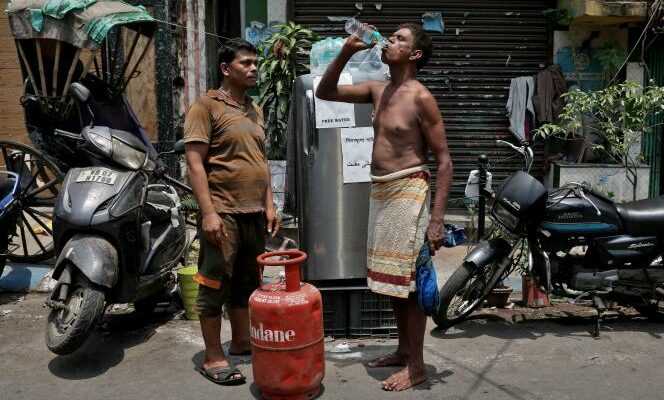Mohini covered his skull with his sari, his face covered in sweat. She struggles to find shade where to put her cart, which she has been pushing for a good kilometer, and the market where she has been to stock up. Tuesday, April 26, the air is hot in New Delhi. 42°C, a real furnace. Mohini (she only gave her first name) does not know her age – “in his fifties”, she said, unsure. Like every morning, she was hard at work from 8 a.m. to sell her vegetables in a residential area in southern Delhi. She spends all day outdoors, whatever the weather. “My husband is sick, if I don’t work, we don’t eat. Even during the monsoon when I have water up to my knees, I continue to work. »
The heat wave that hit the Indian capital will leave him no respite in the days to come. The Indian meteorological department predicts a rise in mercury in northwestern and eastern India until the first weeks of May. Thus, 46°C are expected in New Delhi, Thursday April 28, 48°C in Rajasthan. Such temperatures are normally recorded in May and June, the two hottest months of the year.
The heat wave began on March 11 in New Delhi and in fifteen states, including Rajasthan, Madhya Pradesh and even Himachal Pradesh in the Himalayas. These regions have not experienced a spring. March, which is usually a pleasant month marking the end of winter, was the warmest on record since the inception of weather records, with 9°C above average. It is also one of the driest. April was no better. Eight days of heat wave have already been recorded with peaks at 43-45°C, 5-7°C higher than normal. May promises to be even more challenging.
Rainfall deficit
In India, the meteorological department characterizes a heat wave when the mercury exceeds 40°C in the plains, 37°C in the coastal areas and 30°C in the hills and they are 4.5°C higher than 6 .4°C to normal. Beyond a difference of 6.4°C and from 47°C, it is considered as ” severe “, which has been the case for two months.
The causes of this early phenomenon, according to D. Sivananda Pai of the Institute for Climate Change Studies based in Kottayam, Kerala, are “the anticyclones over western parts of Rajasthan observed in March and the absence of western rain-bearing disturbances”. Northwest India has a rainfall deficit of 87%, central India 70%.
You have 64.43% of this article left to read. The following is for subscribers only.
